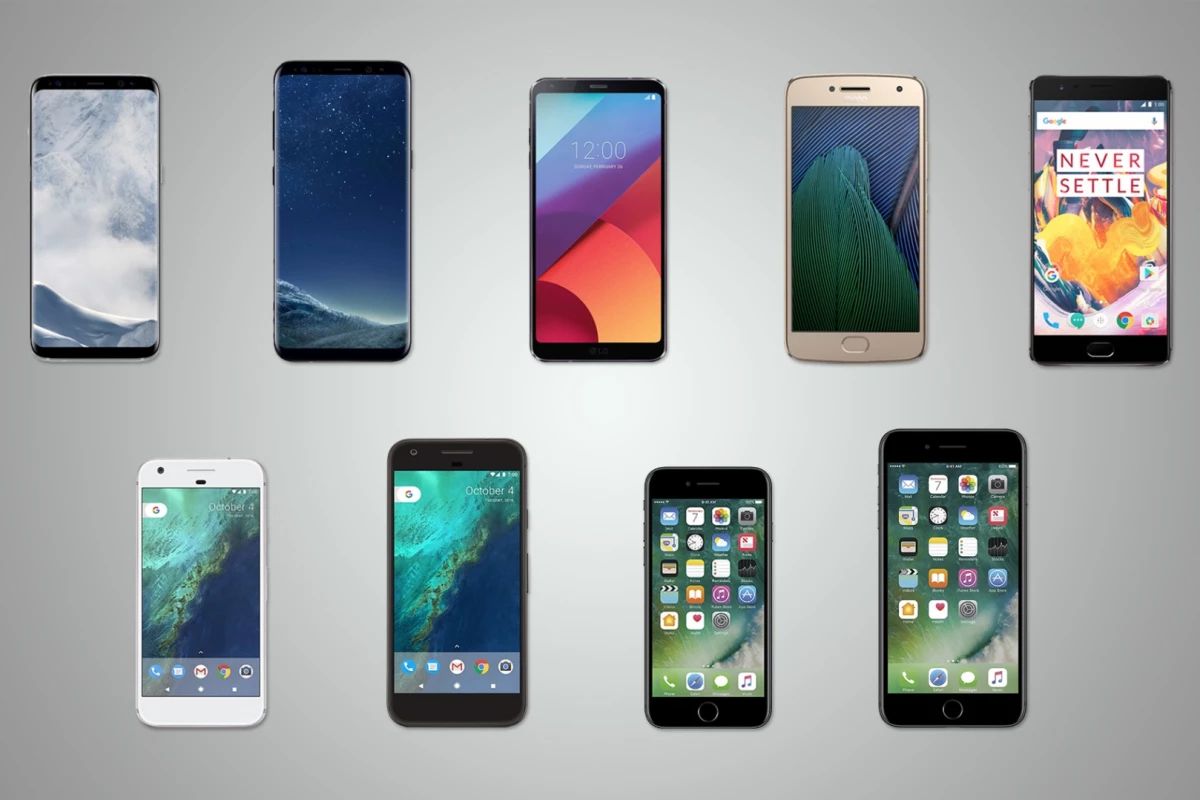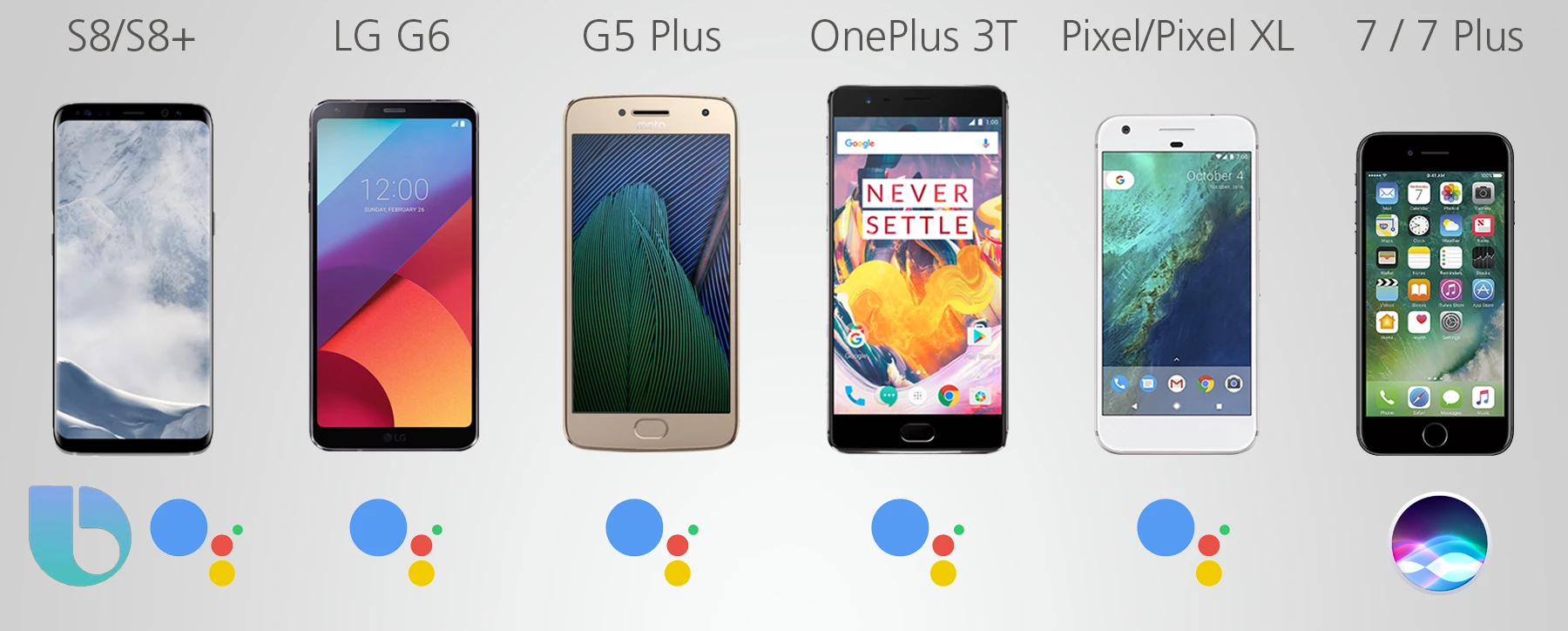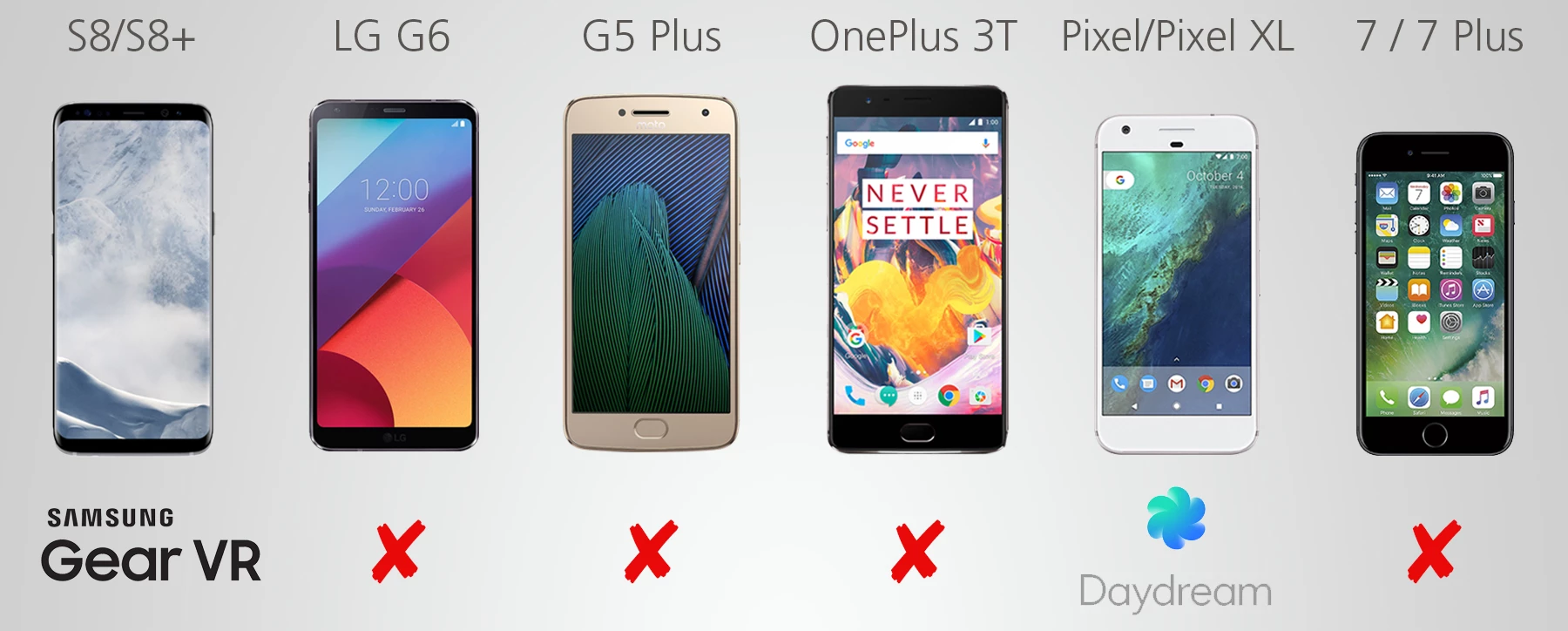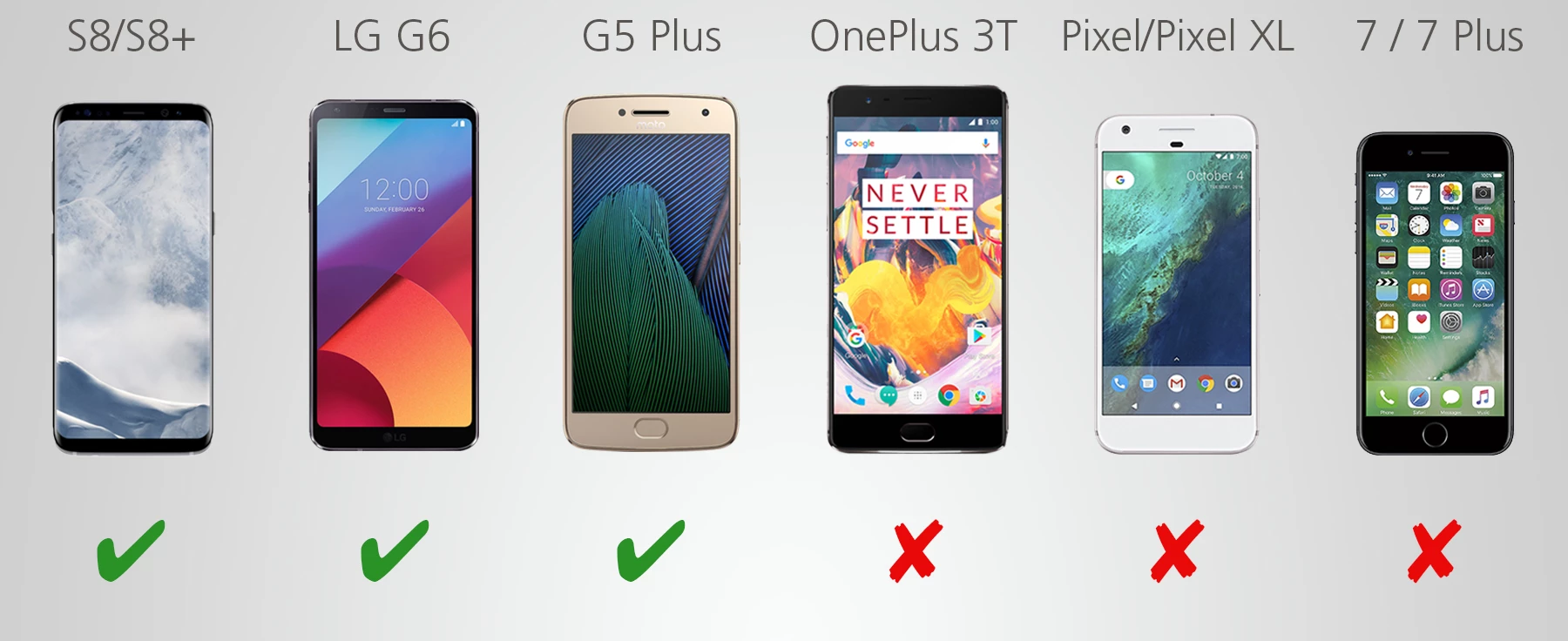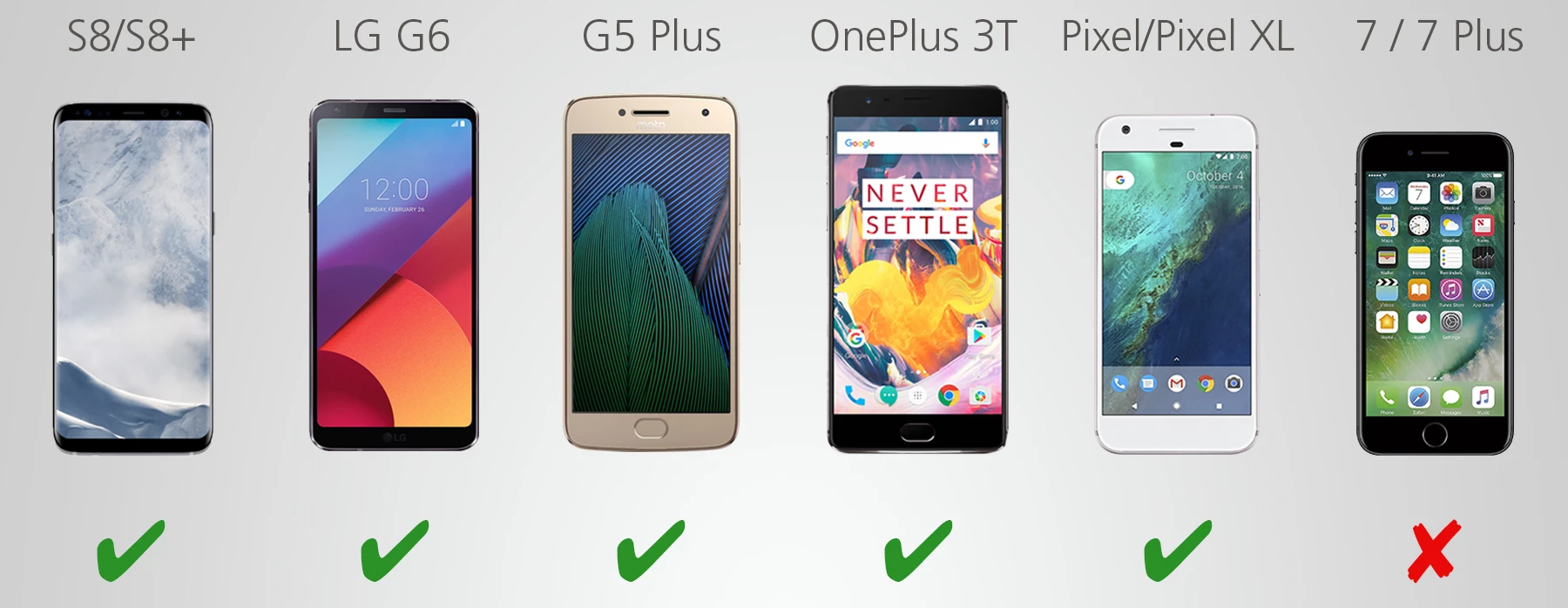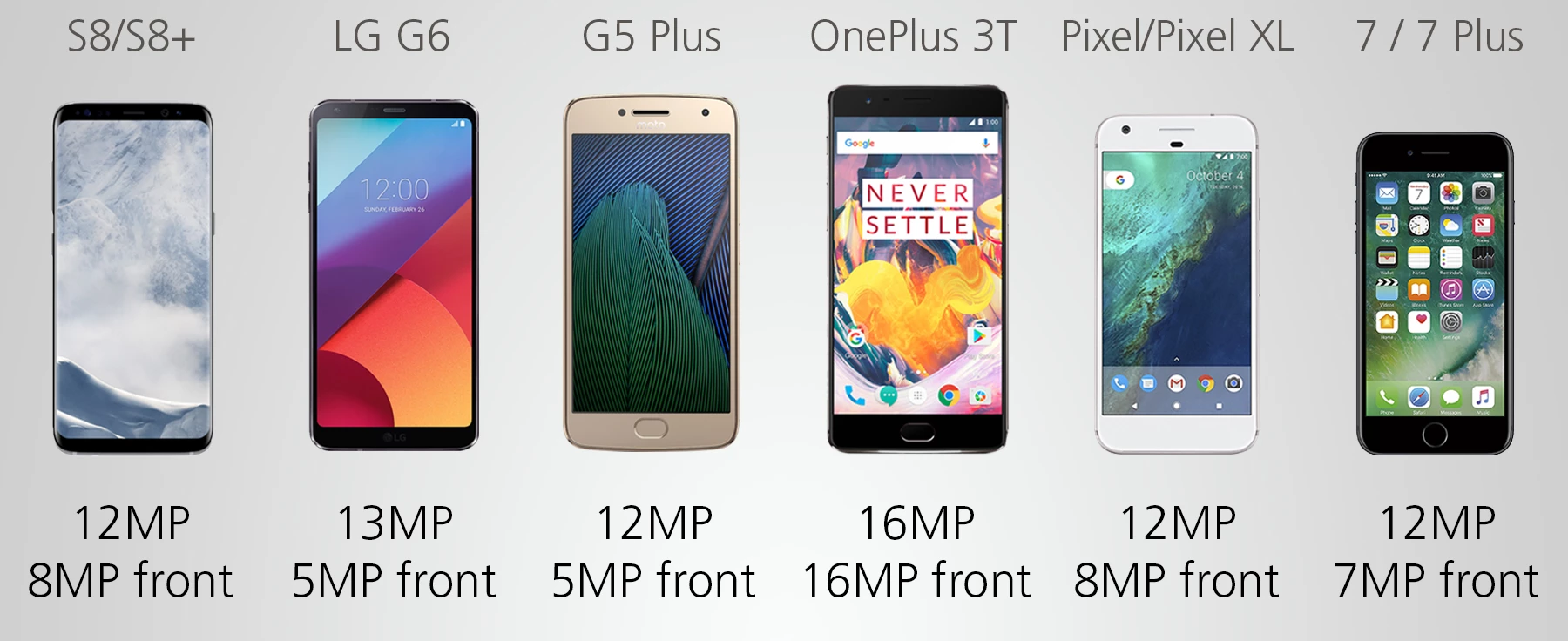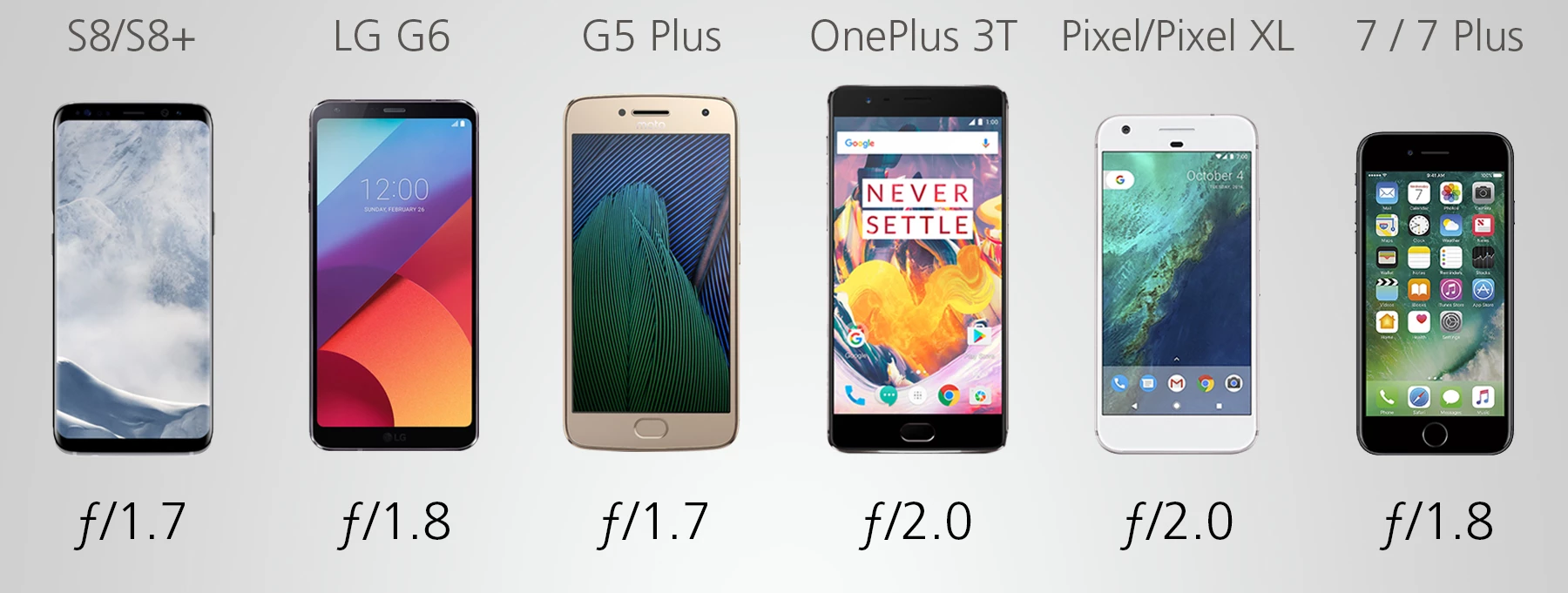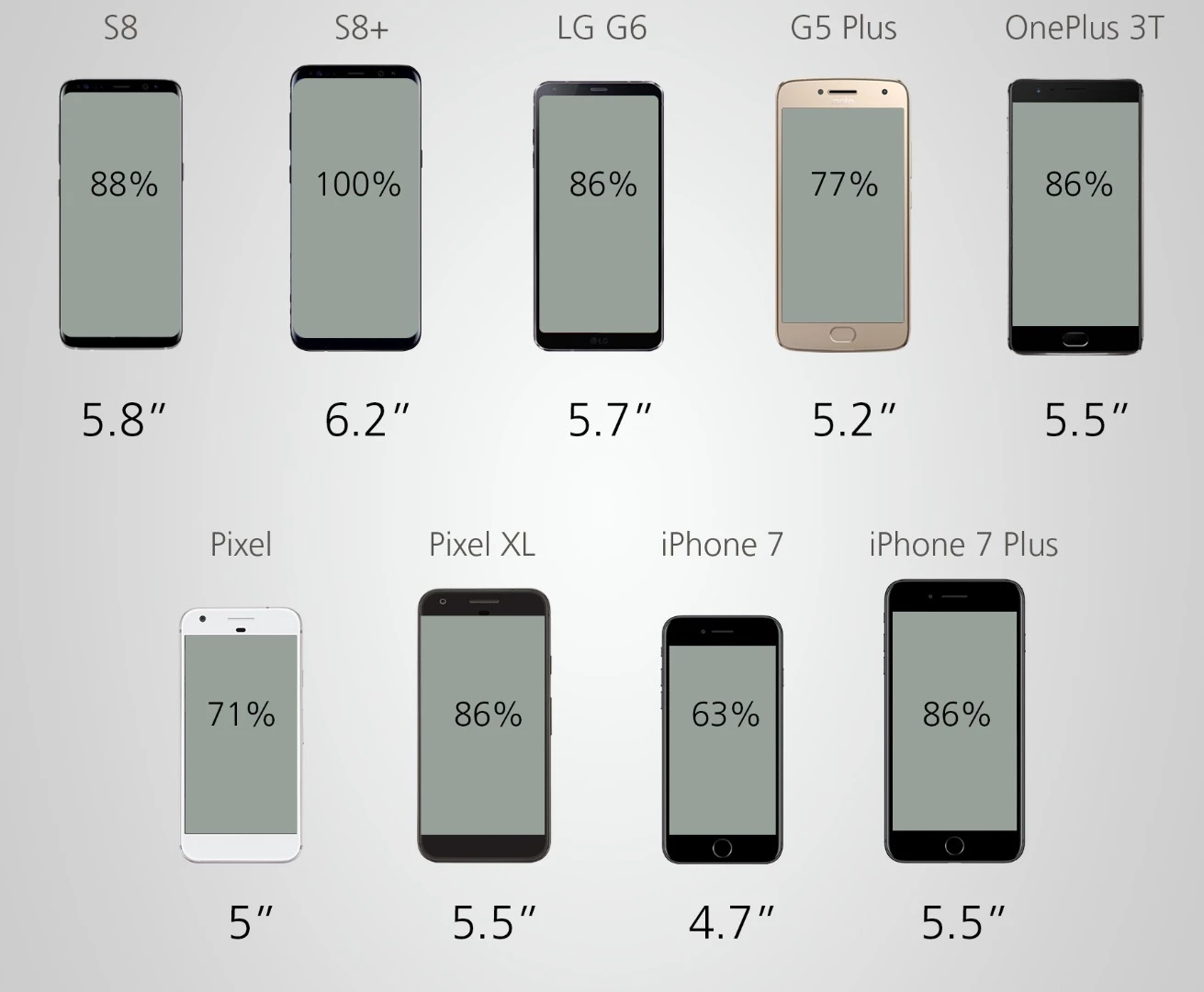We've seen a strong crop of smartphones pop up in the early part of 2017. Here's a roundup of the best recent releases – including a few from the end of 2016 – and a comprehensive comparison of their specs and features.
In this guide, we'll take a look at the following:
- Samsung Galaxy S8 and S8+
- LG G6
- Moto G5 Plus
- OnePlus 3T
- Google Pixel and Pixel XL
- iPhone 7 and 7 Plus
In many categories, flagships with the same maker share the same specs. In those cases, only the smaller variant is represented in the visual.
Size
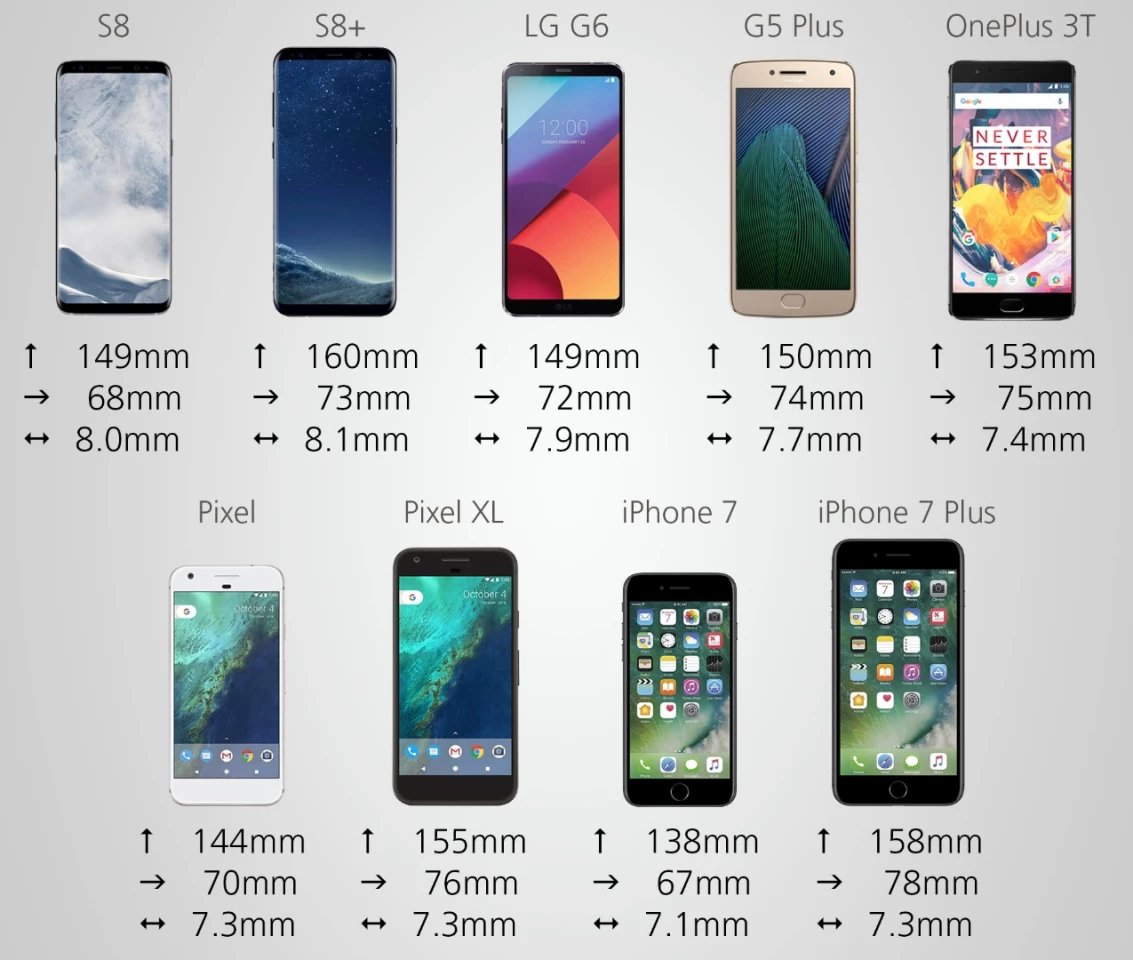
In this crop of flagships, the most petite device is the iPhone 7, while the iPhone 7 Plus and Samsung Galaxy S8+ are the largest. We'd consider everything except for the S8, Pixel and iPhone 7 large enough to fall into phablet territory.
Weight
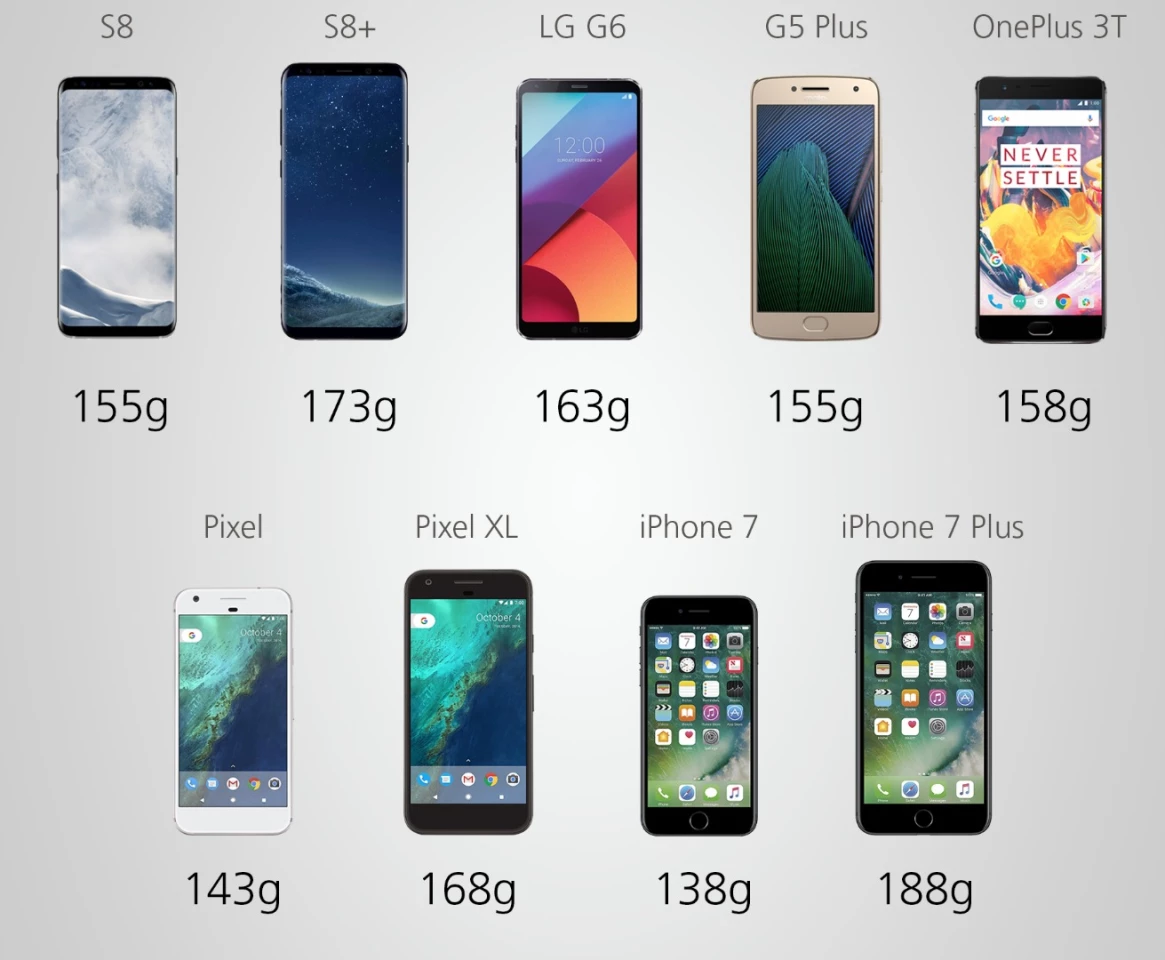
The two iPhones – the iPhone 7 and 7 Plus – take the banners for lightest and heaviest phones, respectively. Even the tall, narrow S8+ is about 15 grams lighter than the iPhone 7 Plus.
To keep some perspective, a US nickel weighs about 5 grams. If you carry your phone in a pocket or purse, having a heavier phone could feel like having a small phone plus a pocket of loose change.
Build materials
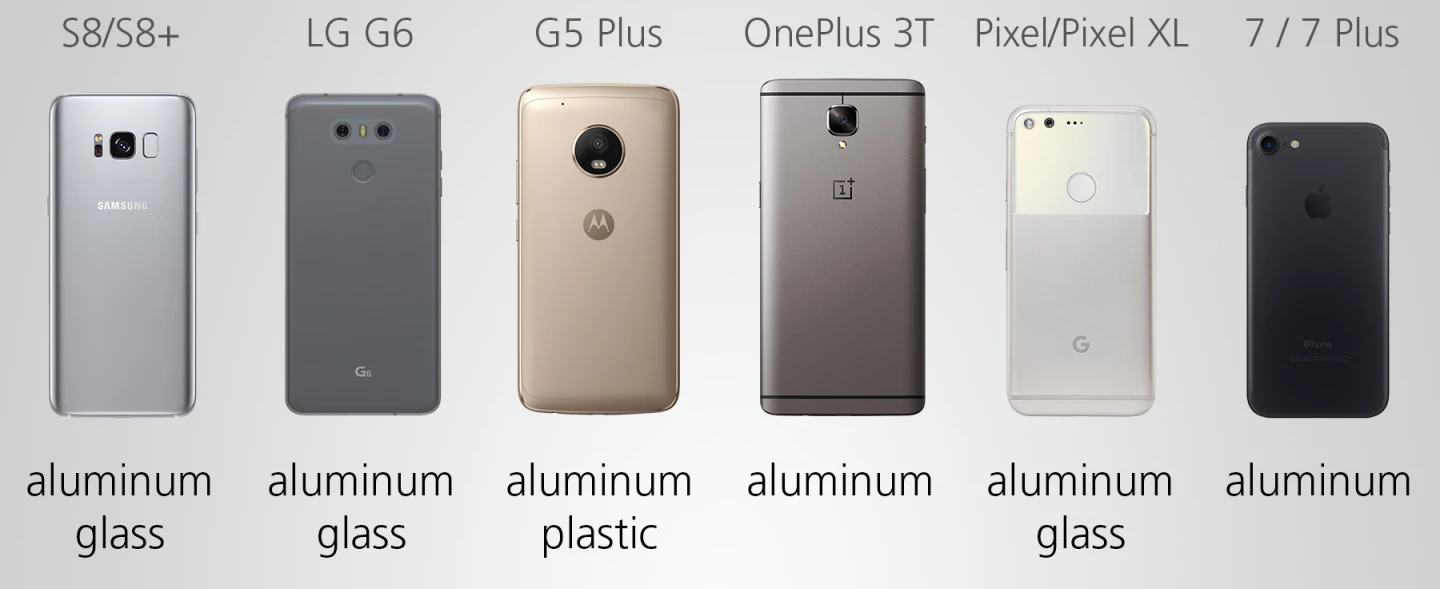
When it comes to materials, we're looking at aluminum, glass and a touch of plastic.
The Galaxy S8 and S8+ have rounded glass backs that curve into a minimal aluminum frame. The LG G6 takes a similar approach to build, except that its glass back is not quite as rounded. The Pixel phones also have some glass, in the form of an accent panel on the upper back portion – the rest is aluminum.
The OnePlus 3T and iPhone 7/7 Plus both have aluminum unibodies. The Moto G5 Plus has an aluminum back with a plastic frame.
Colors
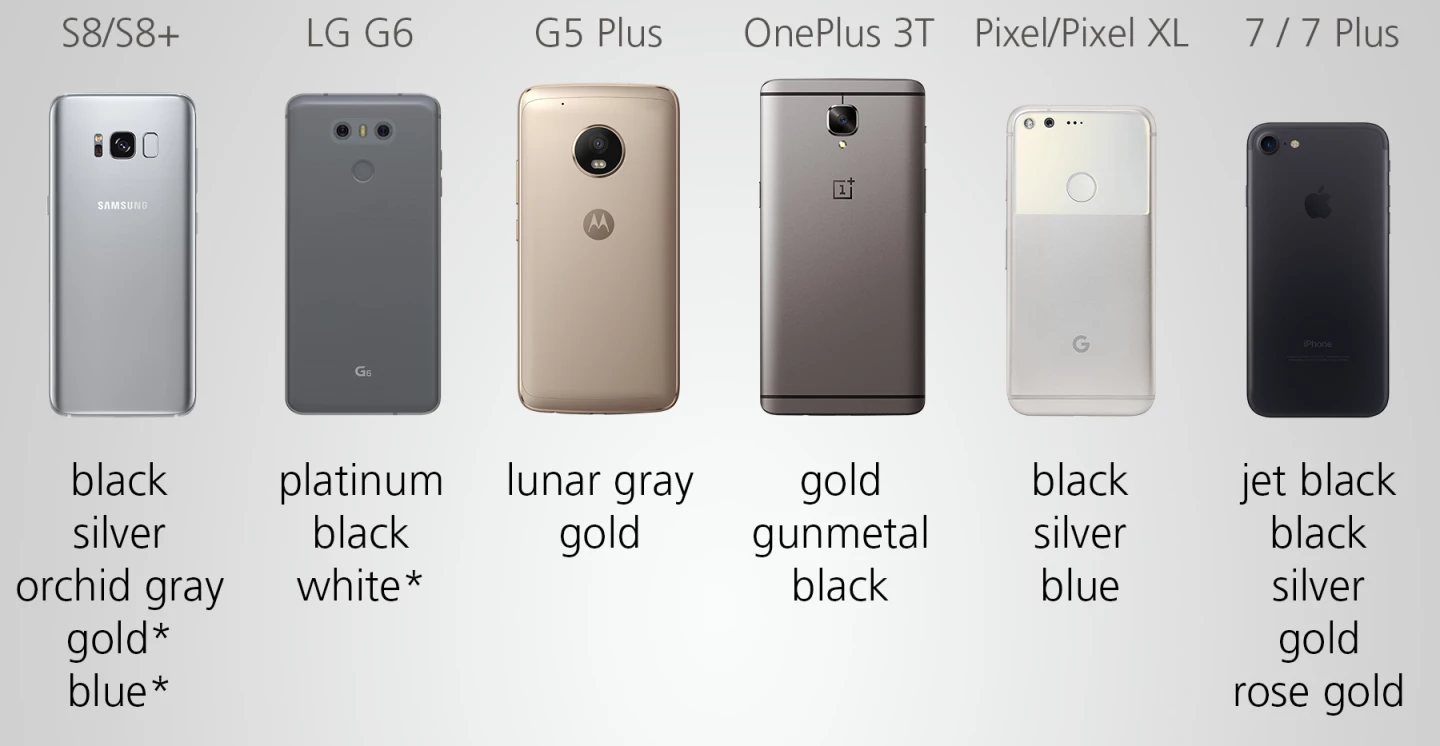
By and large, we're looking at metallics and neutrals. The iPhone offers the most color options, but none of them are particularly adventurous.
Starred color variants are not currently available in the US, but can be found in some international markets.
Display size

There's a trend toward fitting increasingly large displays on same-sized or even smaller devices, with Samsung leading the curve. Even the smaller Galaxy S8 has more overall screen area than larger phones.
It's worth noting that we're starting to see some unusual aspect ratios in smartphone displays. It used to be that a 16:9 aspect ratio was more or less a given. That's still a popular proportion, but we're seeing deviations from Samsung (the S8 and S8+ have an 18.5:9 ratio) and LG (18:9 ratio). For this reason, you can't always rely on diagonal measurement alone as a reliable indicator of overall screen size.
Display resolution
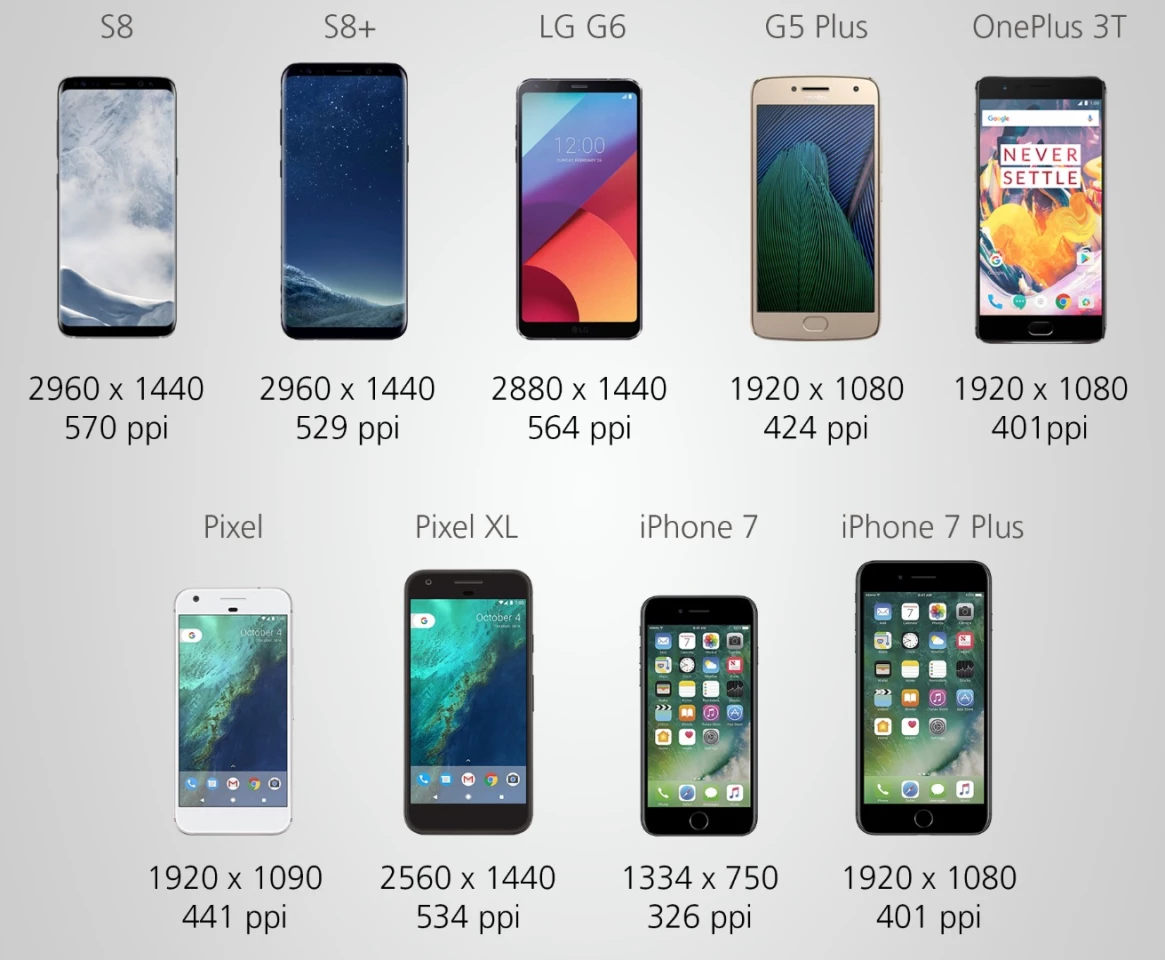
If display resolution is important to you, go for one of the Samsung Galaxy S8 series, the LG G6 or the Pixel XL. All have remarkably pixel-dense screens.
The OnePlus 3T and iPhone 7/7 Plus fall on the lower end of things, but to be fair, we've never had complaints about iPhone display quality.
Display type

Smartphone makers remain split between IPS and AMOLED display technology.
Pressure-sensitive display
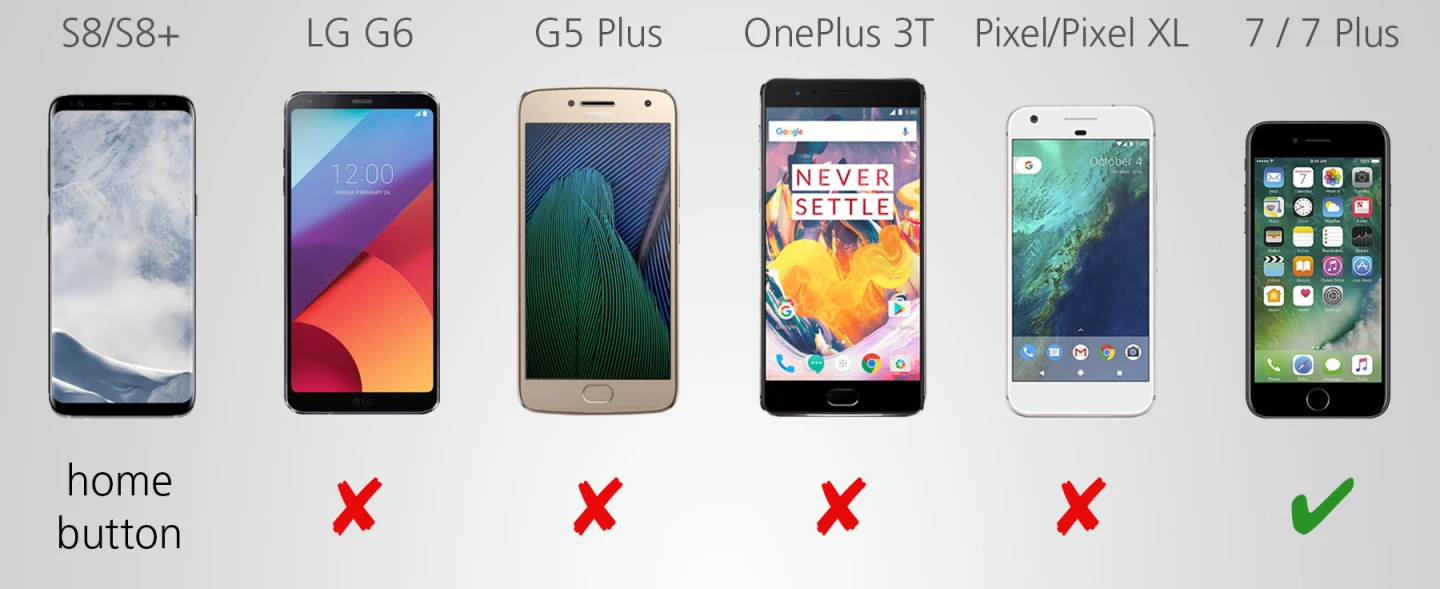
Apple first introduced its 3D Touch pressure-sensitive display technology in the iPhone 6S, and it has since been worked into iOS 10 to allow for navigational shortcuts based on how long and hard you press the screen. It's more than a gimmick, but so far, we've yet to see truly compelling uses for it.
On the Android corner, the Samsung Galaxy S8 series adds a touch of pressure sensitivity to the home button area of the display. This allows easier access to the home screen, even when you're viewing something in full screen mode.
HDR display
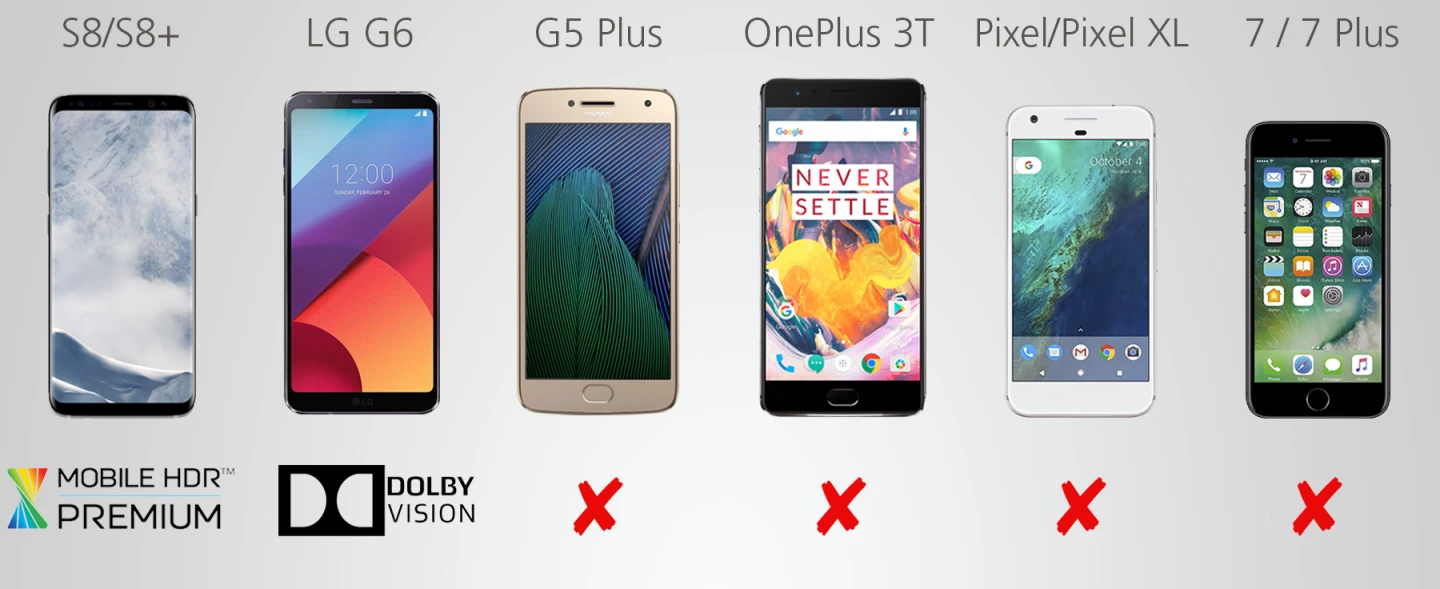
So far, LG and Samsung have both hopped on the HDR wagon, but use different standards. The Dolby Vision tech in the LG G6 allows HDR 10 and Dolby Vision support. The S8 and S8+ are certified Mobile HDR Premium by the UHD Alliance – one of the features that have earned Samsung's so-called Infinity Display accolades from industry experts. Either one supports HDR content from services like Netflix (when available).
Curved display

The S8 and S8+ have rounded displays that emphasize their minimal frames and help give the impression that the phones are made entirely of glass – however, it also means greater breakability. All of the other phones have standard flat fronts.
Camera megapixels

The OnePlus 3T goes for the spec-sheet high with 16 MP in both its front and rear cameras. That should mean significantly sharper selfies, but it's important to remember there are many factors in overall photo quality than resolution alone.
Camera aperture (rear)

The smaller the f-stop, the larger the aperture. A larger aperture can mean perks like better low-light shooting and improved depth-of-field effects. Here, the S8 series and the Moto G5 Plus have the advantage.
Dual-lens camera (rear)
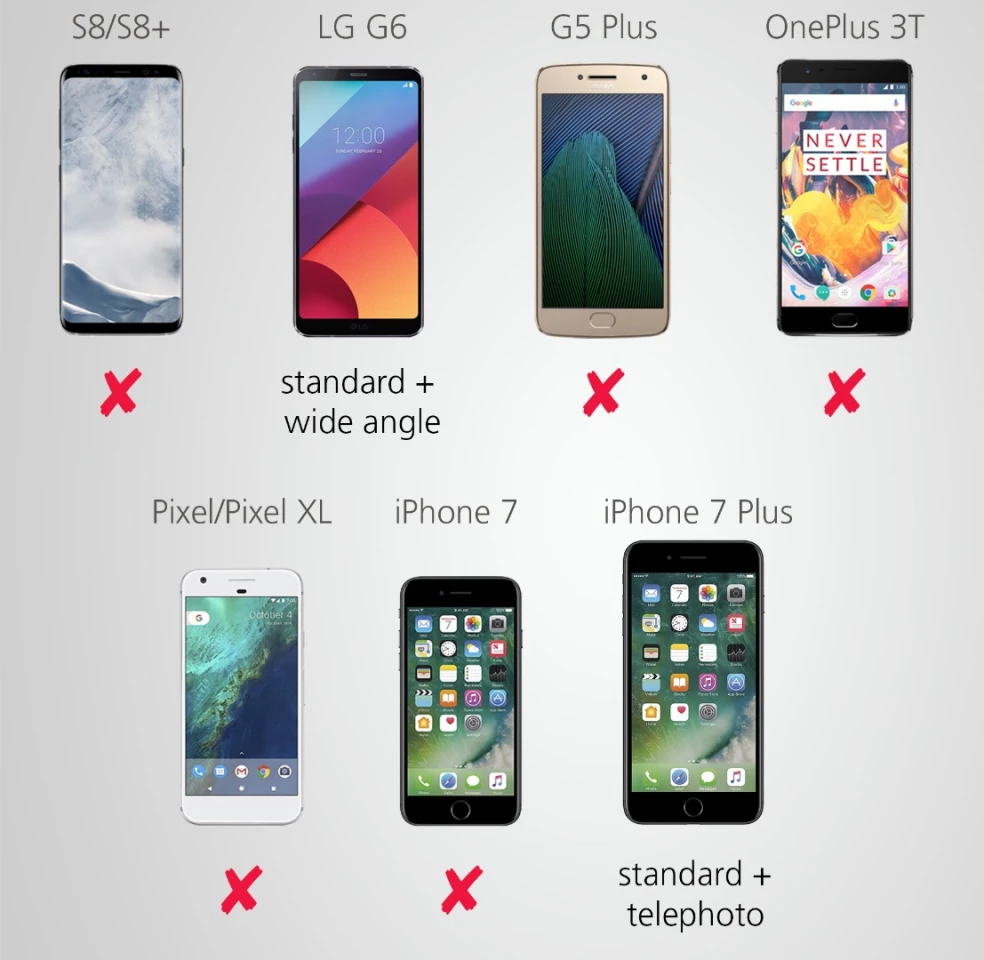
Dual-lens rear cameras are popping up in some premium flagships, but they are not all created equally. The LG G6 combines a standard and wide angle lens, so you can switch back and forth to fit more or less in the frame. The iPhone 7 Plus uses standard and telephoto lenses, which provide 2x optical zoom.
Optical image stabilization (OIS)

OIS is a bit of camera tech that helps eliminate blur from photos by counteracting hand shake. It's absent from the Moto G5 Plus and Pixels.
Battery capacity
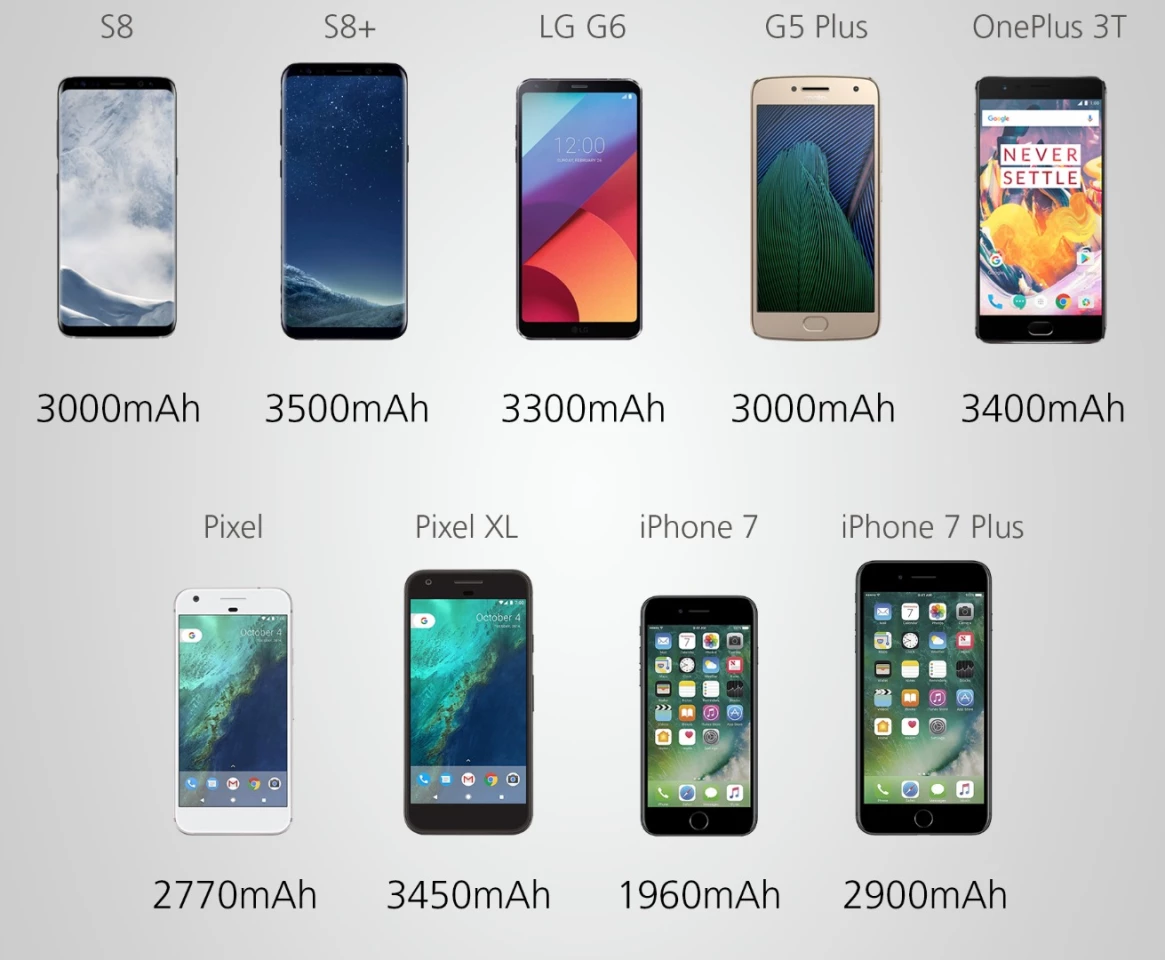
Capacity alone is not an accurate indicator of overall battery life – for example, larger displays are usually more draining – but here, the Galaxy S8+ and the Pixel XL lead the pack.
Battery benchmark (lower is better)
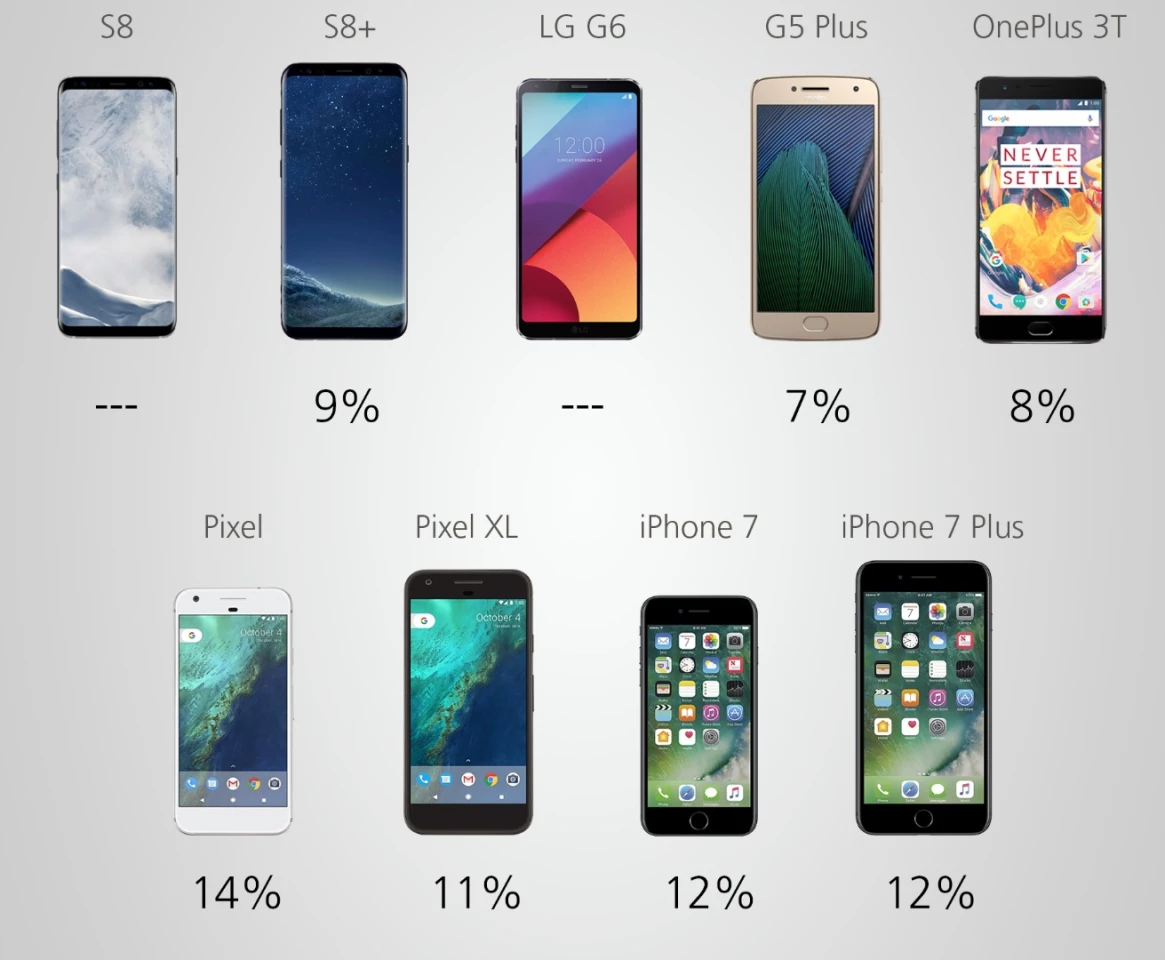
When New Atlas conducts reviews, we perform a benchmark battery test – an hour of streaming video over Wi-Fi at a constant luminescence – after which we record how much battery percentage dropped. (We have not performed full-length reviews on the LG G6 or Galaxy S8, so no data is available for those phones.)
The Moto G5 Plus, OnePlus 3T and Samsung Galaxy S8+ showed the smallest drops in battery percentage. The smaller Google Pixel fared the worst.
Home button
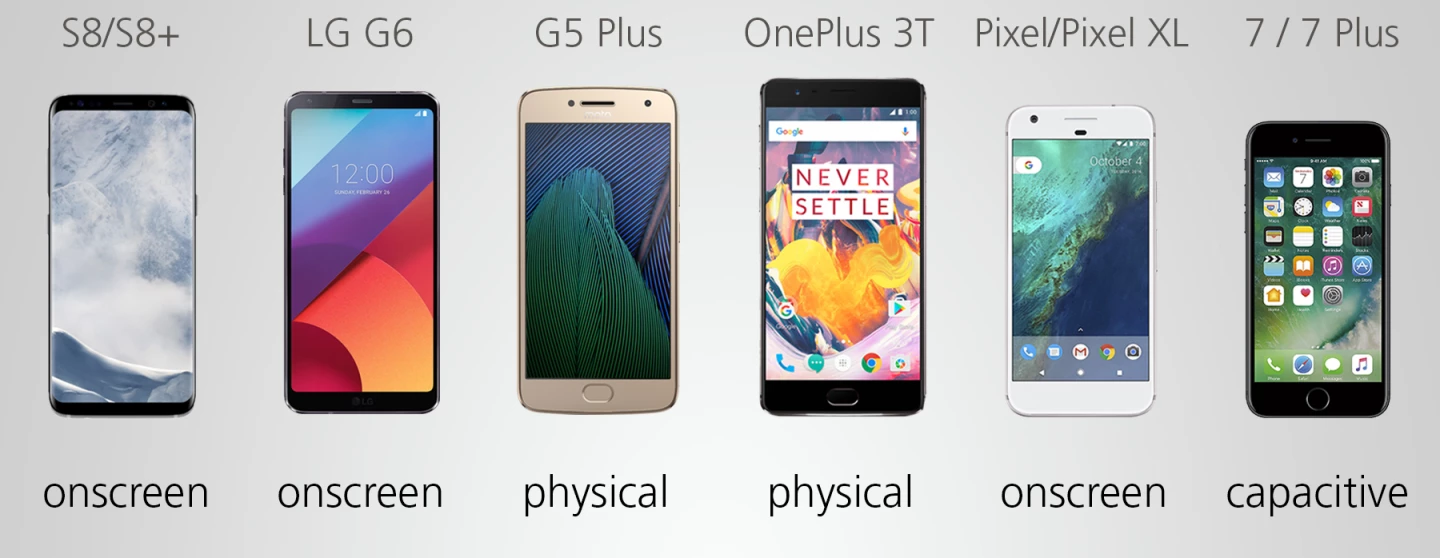
The Galaxy S8 series, LG G6 and Pixels have onscreen home buttons. The G5 Plus and OnePlus 3T have physical buttons below the display. The iPhones have offscreen home buttons that are solid-state: They don't actually move, but give the impression of a click with haptic feedback.
Fast charging
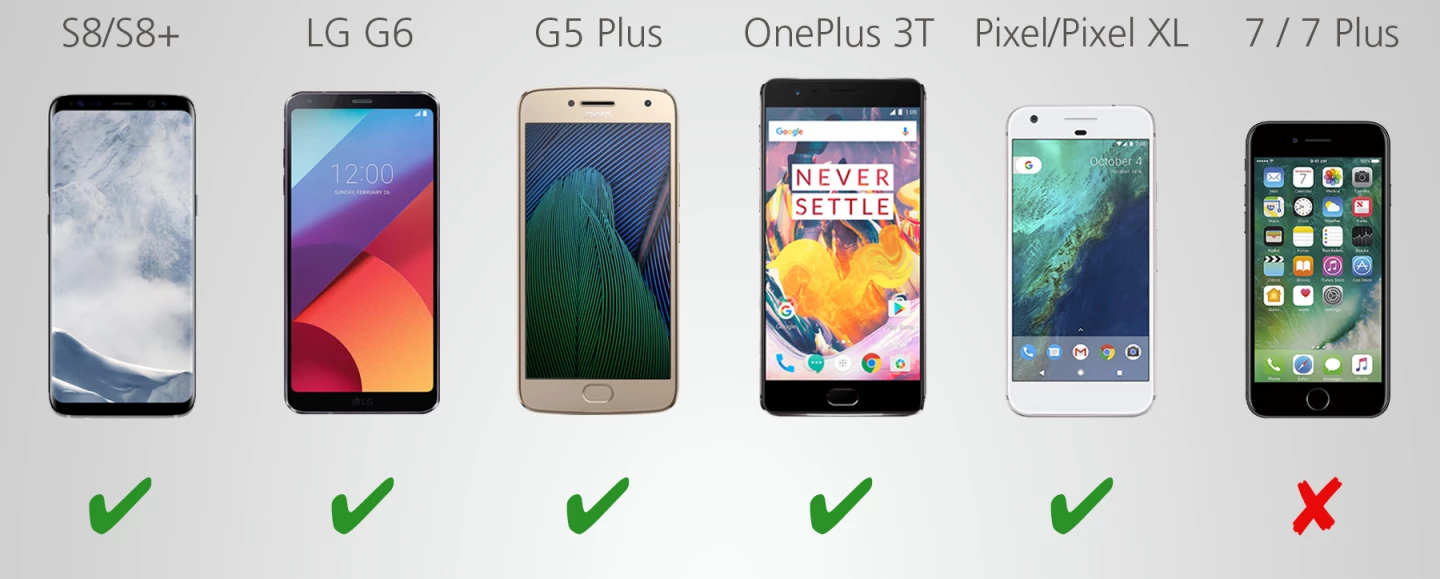
All of the Androids offer some form of fast charging technology, but that feature has yet to hit iPhones.
Wireless charging
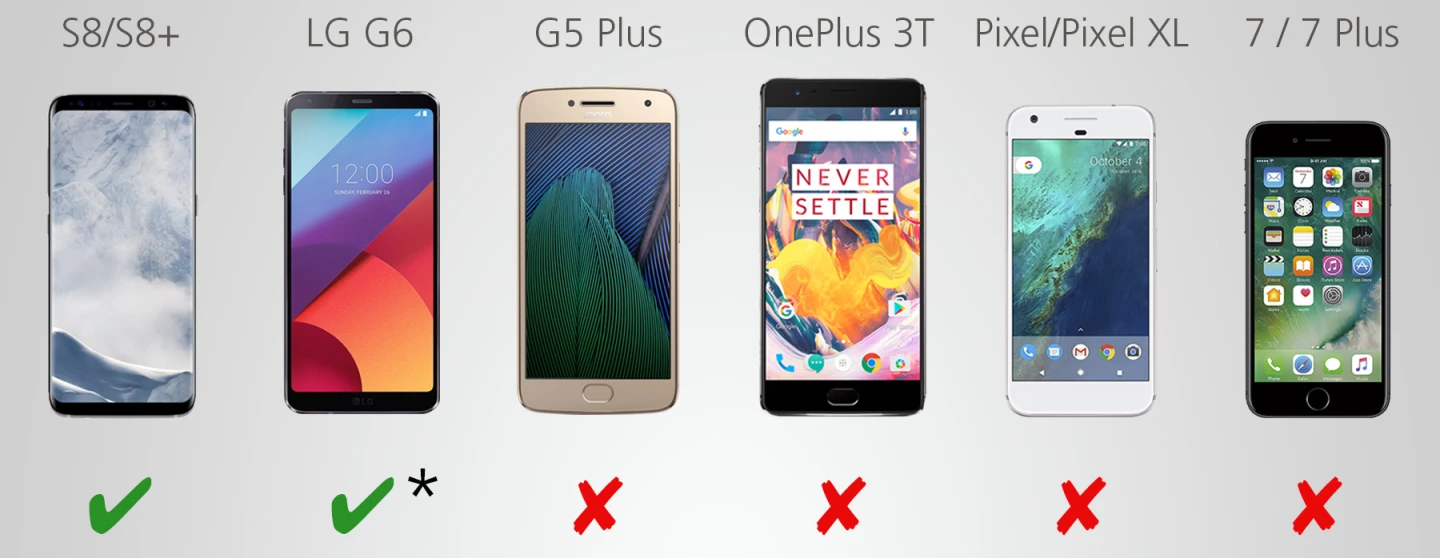
The S8, S8+ and LG G6 all support wireless charging (with a sold separately charging pad) – in the US. The Samsung phones even support a certain degree of fast wireless charging. In international markets, the G6 does not contain the requisite technology.
Processor

The S8 series contain the latest Snapdragon 835 processors in the US and other markets, but Samsung's own (similarly capable) Exynos 8895 chips elsewhere. The iPhones use Apple's A10 chipset, which clocks in comparably. Last year's Snapdragon 821 shows up in all of the other phones, excepting the Moto G5 Plus, which contains a more budget-friendly Snapdragon 625.
RAM

4 GB is the most frequently seen amount of memory in this selection of Android phones. The entry-level G5 Plus has 2 GB, and the OnePlus 3T tops the scale with 6 GB. The amount of memory in the iPhone 7 and 7 Plus, which have 2 GB and 3 GB respectively, seems low in comparison, but to be fair, the two operating systems use RAM differently.
Built-in storage
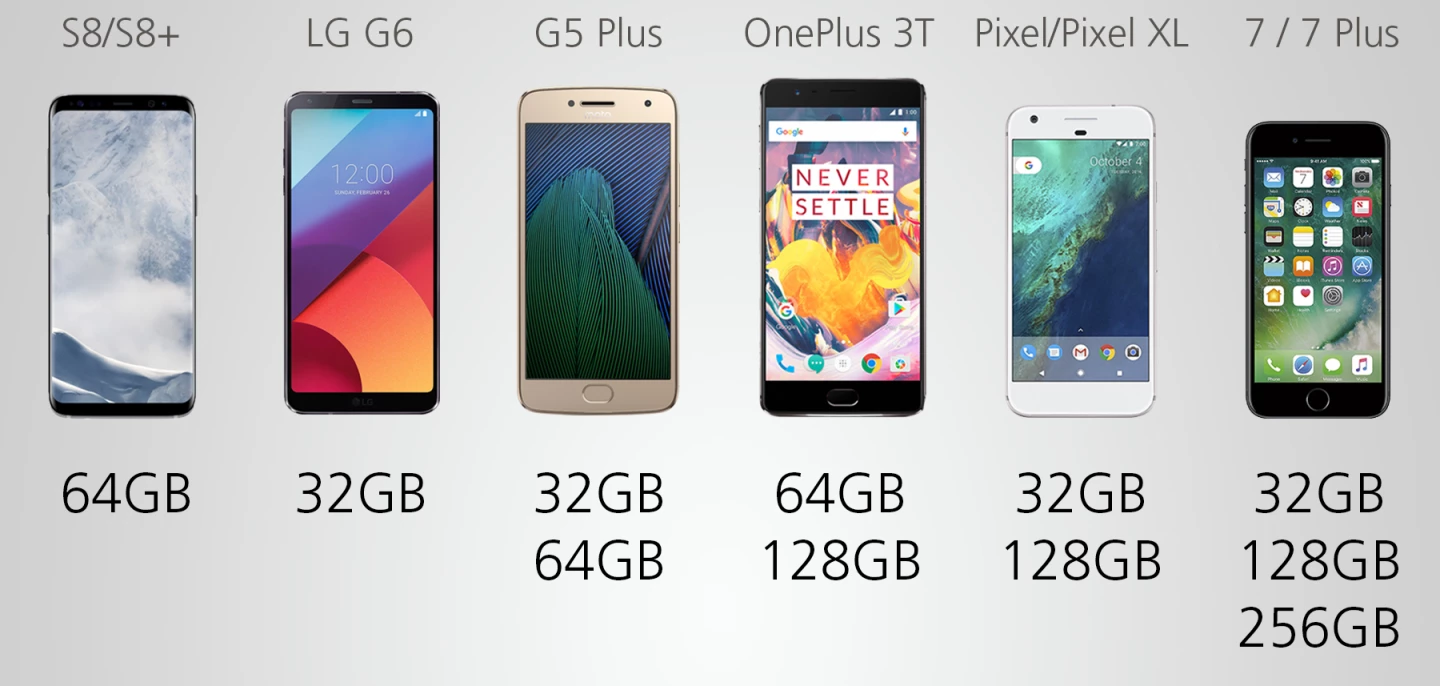
32 GB of storage is the starting point for the LG G6, Moto G5 Plus, Pixel/Pixel XL and the iPhones. Samsung and OnePlus start off with 64 GB. With the G5 Plus, 3T, Pixels and iPhones, you can pay more for extra storage.
MicroSD

If you're really concerned about storage, then Samsung, LG and Motorola have you covered with microSD slots for expandable storage.
Hi-Fi audio
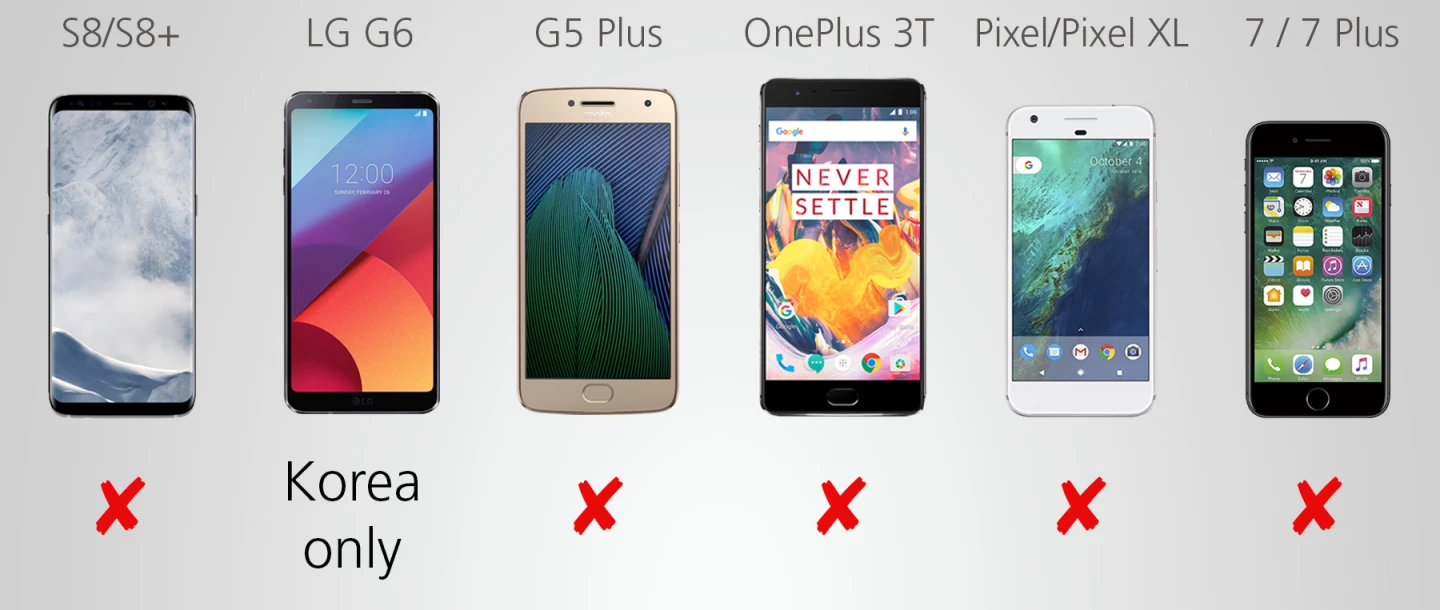
None of these phones offer Hi-Fi audio worldwide. The LG G6 does include Quad DAC in Korea, but by and large, audiophiles are out of luck in this batch of flagships.
Headphone jack
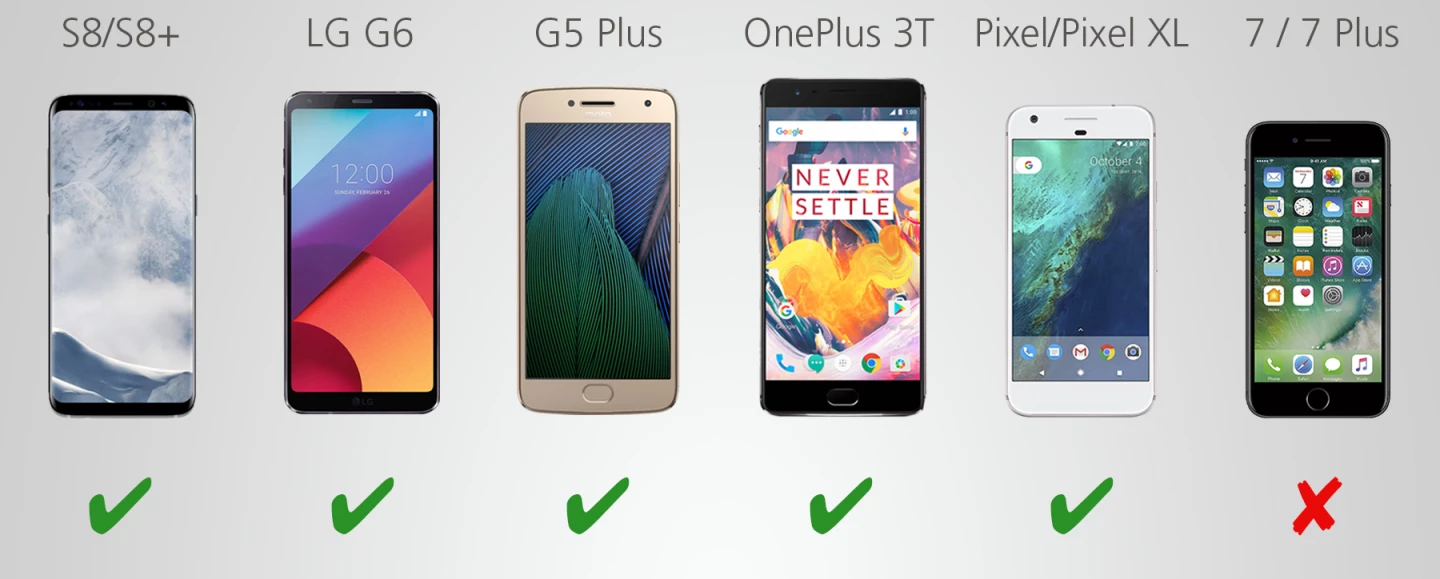
Apple axed the headphone jack in the iPhone 7 and 7 Plus, but none of these other makers followed suit.
Bundled headphones
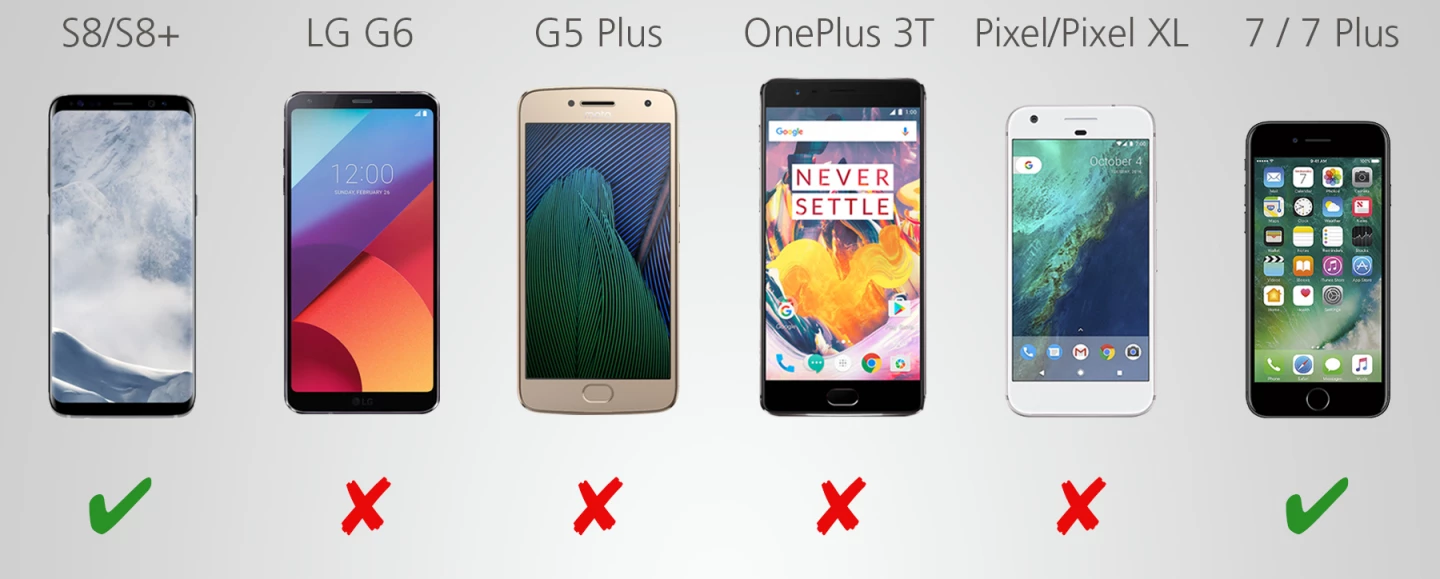
The Samsung flagships are bundled with a pair of AKG headphones that retail for US$99 on their own. The iPhones come with a pair of wired Lightning port earbuds, as well as a Lightning-to-headphone-jack adapter so you don't need to give up the 'phones you already use.
Desktop PC dock

Alongside its launch of the Galaxy S8 and S8+, Samsung announced the DeX dock (sold separately for $150) which lets you use your S8 series phone to power a desktop-like computing experience on a separate monitor, keyboard and mouse.
VR headset

Looking for a phone that lets you experience mobile virtual reality beyond basic Google Cardboard-like functionality? The S8 and S8+ support the Samsung Gear VR headset, which has a better content library at this point than the Google Daydream View, which is supported by the Pixel and Pixel XL.
Voice assistant

Apple stands alone with Siri, but Google Assistant has rolled out to all recent Android phones. Samsung debuted its own virtual assistant, Bixby, in the S8 flagships, and even built a dedicated Bixby activation button in the side of the phone. However, full Bixby functionality has not yet rolled out to these recently released phones.
Fingerprint sensor
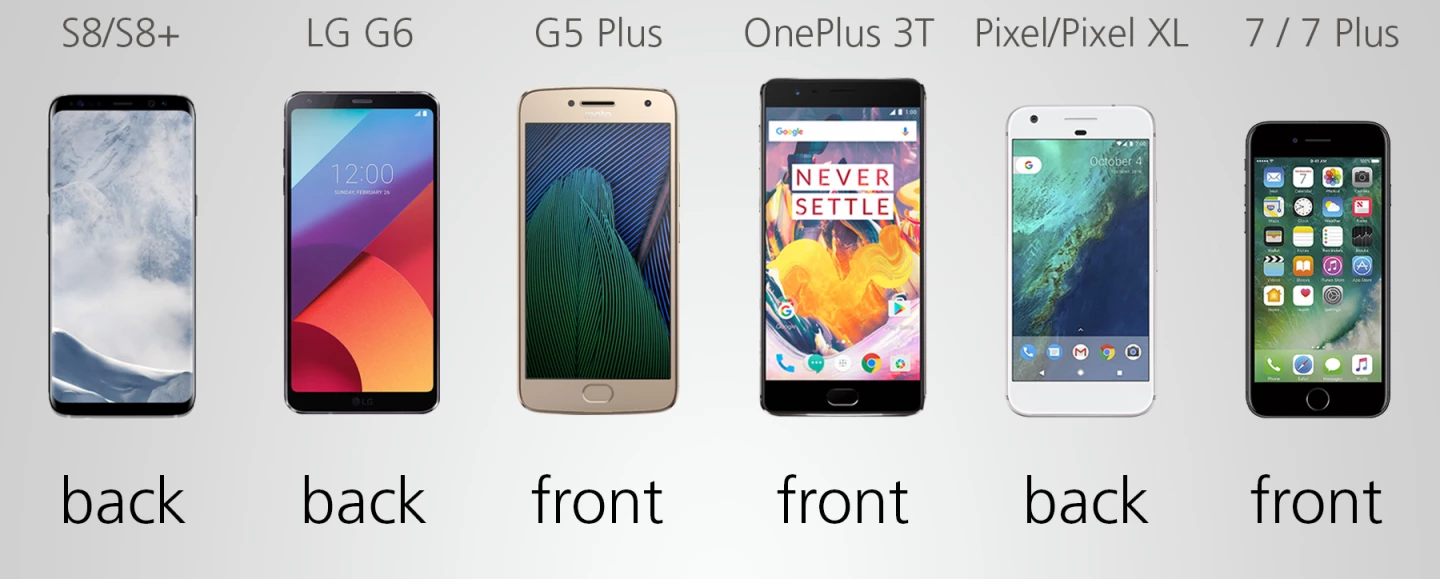
The phones with onscreen home buttons have fingerprint sensors on the back. Those with offscreen home buttons have fingerprint sensors embedded in the front button.
Iris scanning
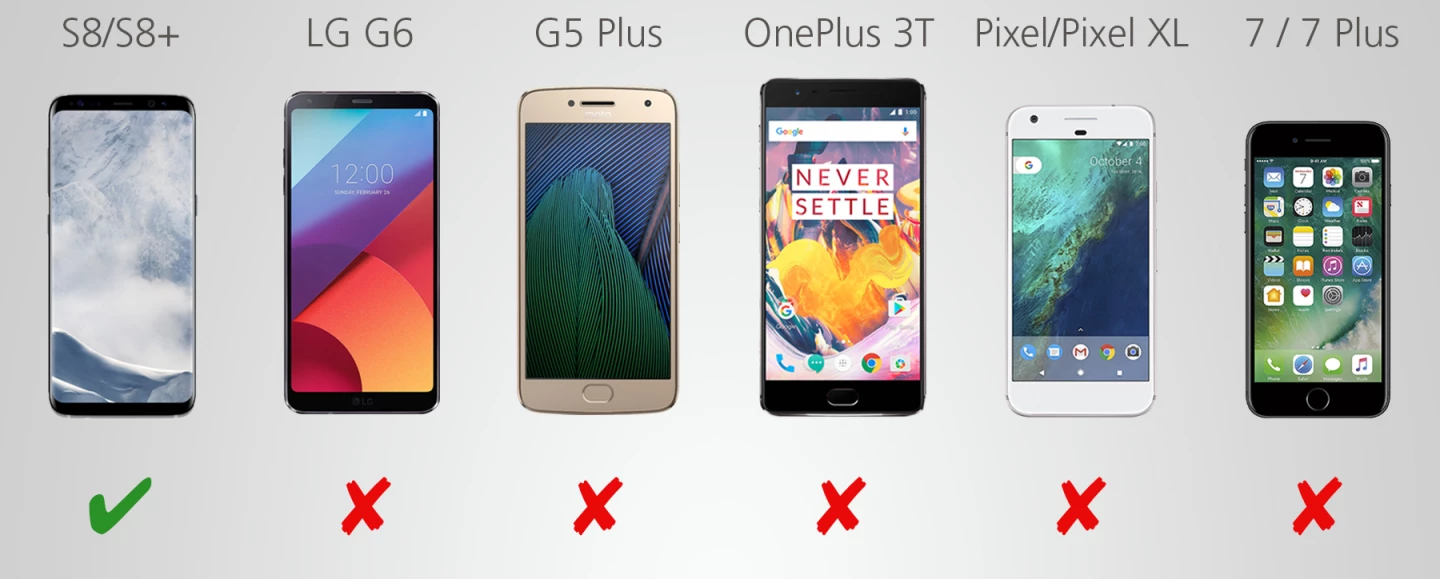
If a super-techy biometrics login option appeals to you, the S8 and S8+ can scan your one-of-a-kind peepers for phone access. This feature has been much improved since we first saw it on the ill-fated Note 7.
Face recognition

Thanks to security options in the Nougat operating system, all of these Androids have a form of face recognition through the "Trusted Face" feature. Samsung adds its own take on that technology in the S8 and S8+, but it may not be as secure as you think.
Mobile payments
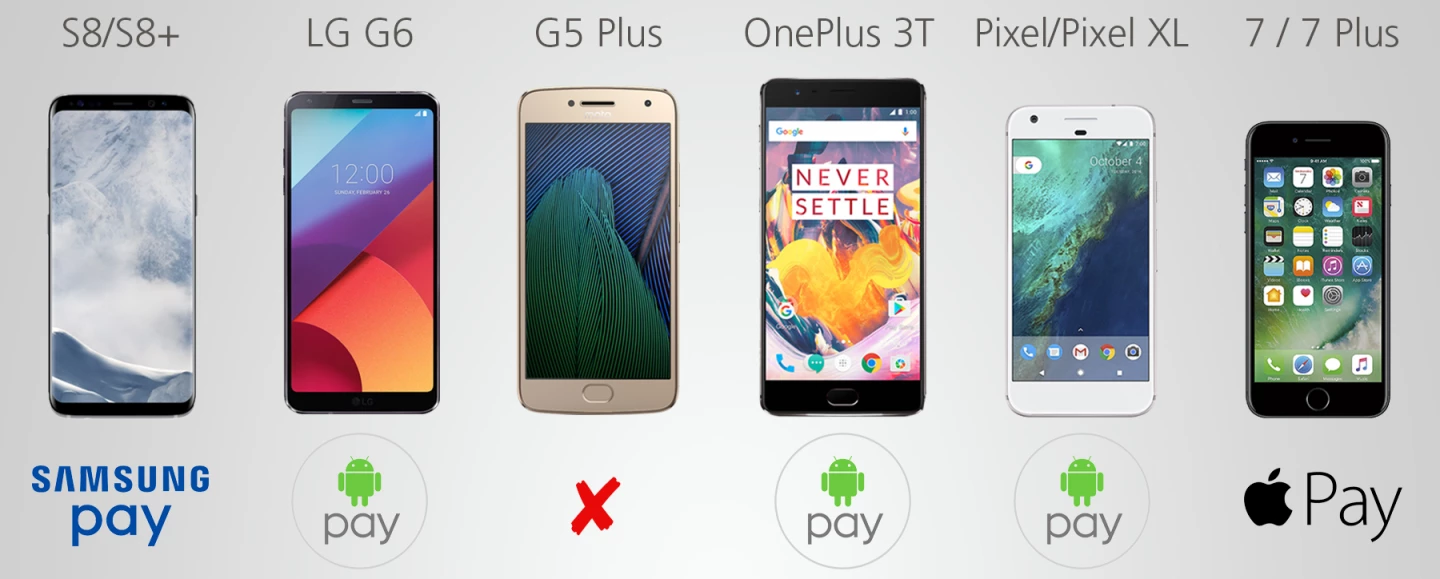
The Moto G5 Plus does not contain the requisite NFC technology to support mobile payments. Other than that, the iPhones support Apple Pay, while the G6, 3T and Pixels support Android Pay. The S8 flagships support Samsung Pay, which has an advantage over the other payment systems: It can imitate a magnetic stripe card, which lets it be accepted at retailers without an NFC reader.
Software
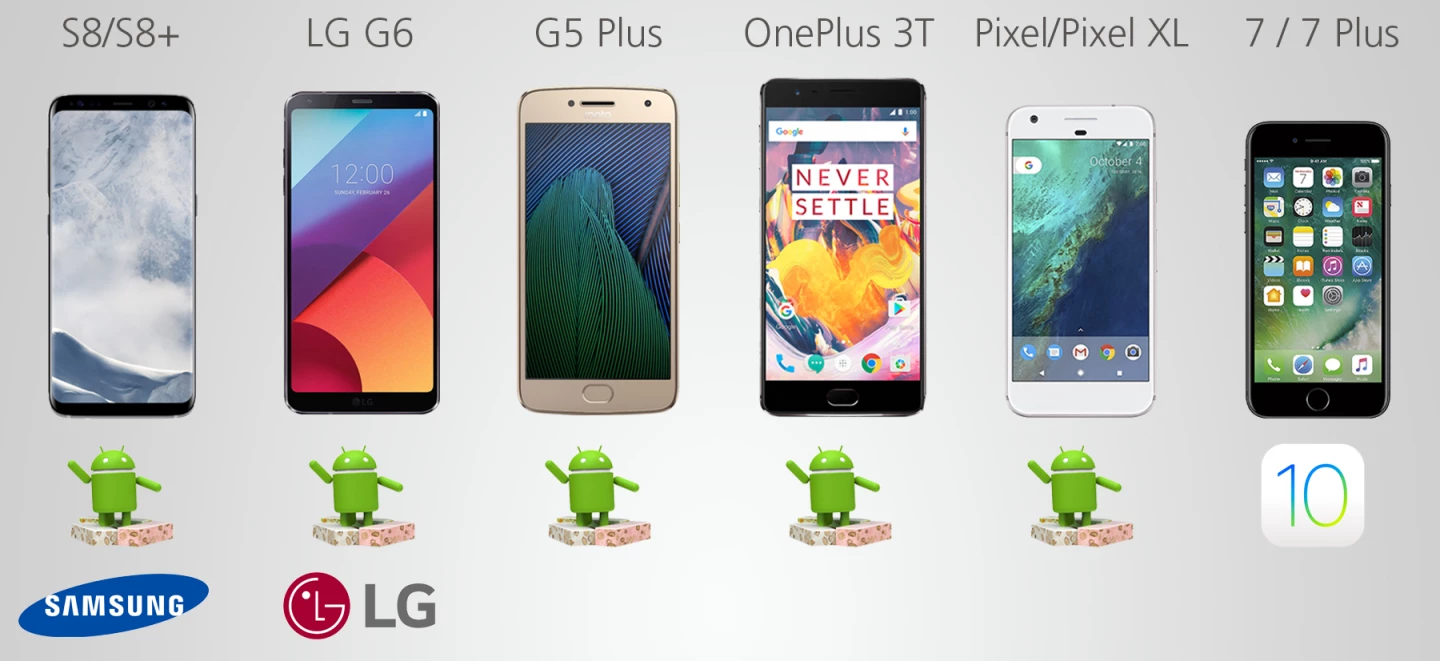
The G5 Plus, OnePlus 3T and Pixels all run pure Android Nougat (or very close to it). As Google products, the Pixels will be first in line for software updates in the near future. Samsung and LG flagships run Nougat as well, but skinned with the makers' own UI (which generally comes with a bit of bloat and slower performance, in our experience). The iPhones, of course, run iOS 10, Apple's latest mobile operating system.
Release
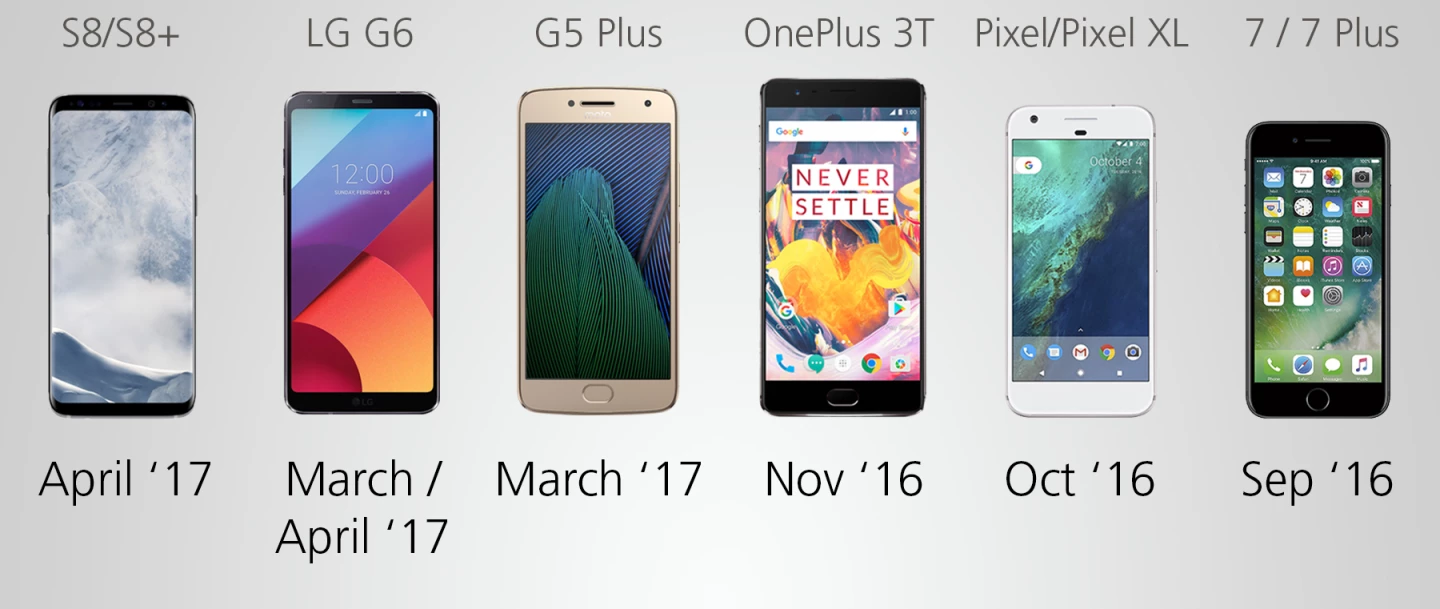
All of these phones were released within the last several months. The Samsungs are the most recent; the iPhones, which have been around since September of last year, are the oldest.
Starting price (full retail)
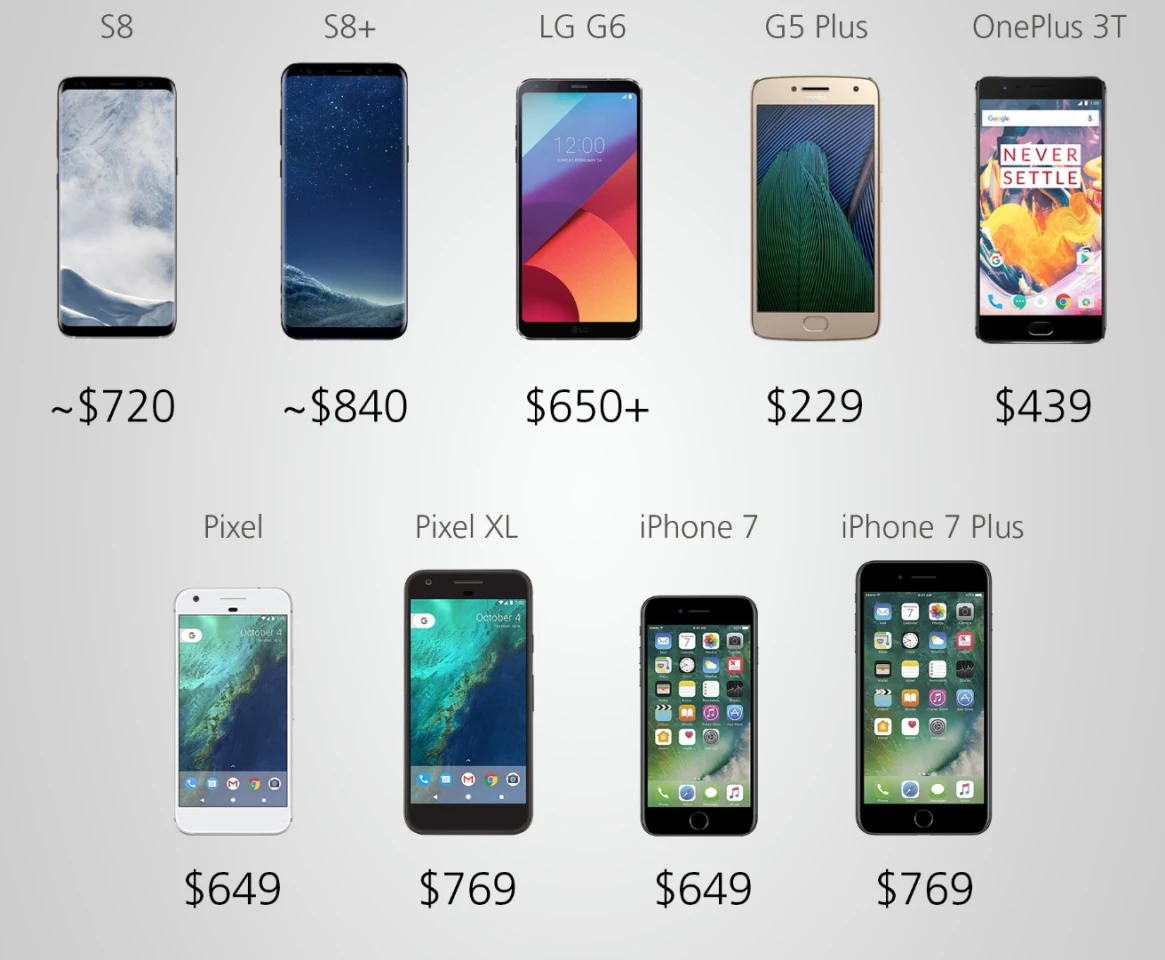
Prices run the gamut from the budget-friendly Moto G5 Plus starting at US$229, to a staggering $840 for the top-shelf Galaxy S8+ (though Samsung and LG prices vary according to payment plan and carrier). The OnePlus 3T is another high-value, low-priced option, while all of the others fall in the $650-$770 range.
For the kind of information that you won't find on spec sheets, browse New Atlas' reviews and hands-on impressions:
